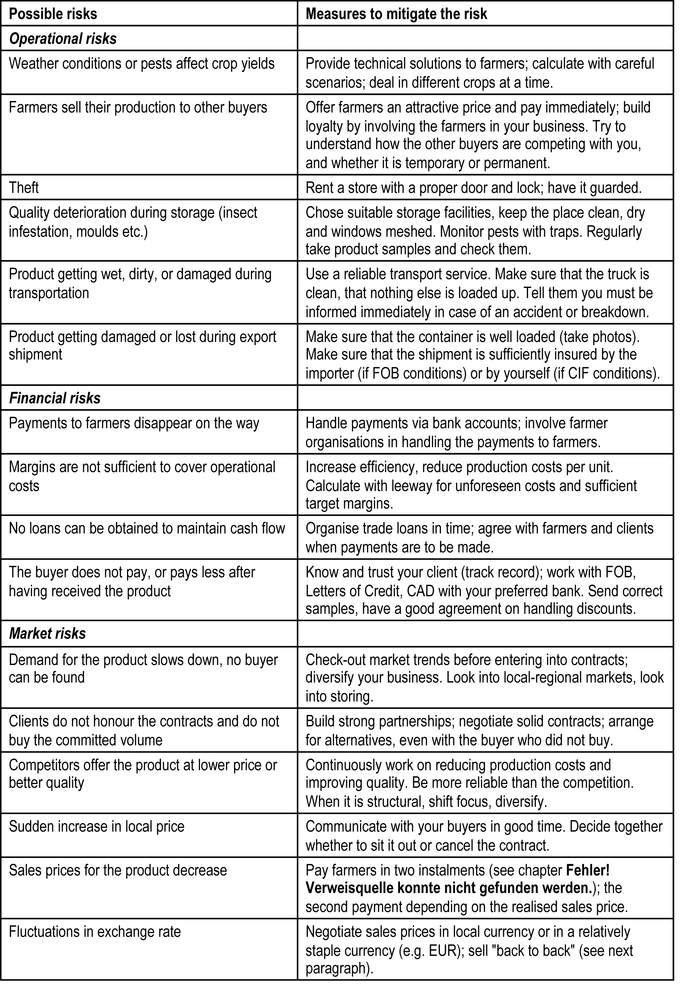- corporate risk
- international risk (including currency risk)
- industry-specific risk
- market risk
- stand-alone risk
- project-specific risk
Each of these risks addresses an area in which some sort of volatility could forcibly alter the plan of firm managers. For example, market risk involves the risk of losses in position due to movement in market positions.
There are different ways to measure and prepare to deal with risks as well. One such way is to conduct a sensitivity analysis. Sensitivity analysis is the study of how the uncertainty in the output of a model (numerical or otherwise) can be apportioned to different sources of uncertainty in the model input.
A related practice is uncertainty analysis which focuses rather on quantifying uncertainty in model output. Ideally, uncertainty and sensitivity analysis should be run in tandem. Another method is scenario analysis, which involves the process of analyzing possible future events by considering alternative possible outcomes.
For example, a financial institution might attempt to forecast several possible scenarios for the economy (e.g., rapid growth, moderate growth, slow growth), and it might also attempt to forecast financial market returns (for bonds, stocks, and cash) in each of those scenarios. It might consider sub-sets of each of the possibilities. It might further seek to determine correlations and assign probabilities to the scenarios. Then it will be in a position to consider how to distribute assets between asset types (i.e., asset allocation). The institution can also calculate the scenario-weighted expected return (which figure will indicate the overall attractiveness of the financial environment). It may also perform stress testing, using adverse scenarios.
Risk Aversion
Risk aversion describes how people react to conditions of uncertainty and has implications for investment decisions.
Learning Objectives
Evaluate a person’s risk aversion
Key Takeaways
Key Points
- Risk aversion is the reluctance of a person to accept a bargain with an uncertain payoff rather than another bargain with a more certain, but possibly lower, expected payoff.
- People can be risk averse, risk neutral, or risk loving. A risk averse person will generally take a guaranteed outcome even if it has a lower expected payout than a gamble, while a risk lover will take on the gamble unless the guaranteed payoff is greater than the expected payoff of the gamble.
- Firm management can adopt different stances based on how risk averse they feel they should be, given different market qualities and firm conditions. They will make capital investments that they feel will have the best payoffs, given the risks involved.
Key Terms
- Risk Aversion: Risk Aversion is a concept that addresses how people will react to a situation with uncertain outcomes. It attempts to measure the tolerance for risk and uncertainty. Risk aversion is the reluctance of a person to accept a bargain with an uncertain payoff rather than another bargain with a more certain, but possibly lower, expected payoff.
In the realm of finance and economics, Risk Aversion is a concept that addresses how people will react to a situation with uncertain outcomes.
It attempts to measure the tolerance for risk and uncertainty. Risk aversion is the reluctance of a person to accept a bargain with an uncertain payoff rather than another bargain with a more certain, but possibly lower, expected payoff. For example, a risk-averse investor might choose to put his or her money into a bank account with a low but guaranteed interest rate instead of investing in a stock that may have high expected returns, but also involves a chance of losing value. Risk aversion can be applied to many different situations, including investments, lotteries, and other situations with uncertain outcomes. Because organizations are composed of individuals, risk aversion at the individual level plays a role in organizational decision making.
People fall under different categories of risk aversion. If we look at an example where a person could receive 50 dollars without risk, or take a gamble where they receive 100 dollars or 0 dollars depending on the outcome of a coin flip, we can explain the differences. We see when we use the expected payoffs of each scenario we see that each has an expected payoff of 50 dollars. Situation one has a 100% chance of getting 50 dollars so it’s expected payoff is (1)(50)=50. For the second situation, the expected payoff deals with a 50-50 chance of getting 100 or 0 dollars so, (.5)(100)+(.5)(0)=50. This is important to know for this example. A risk-averse, or risk avoiding person would take the guaranteed payment of 50, or even less than that (40 or 30) depending on how risk averse they are. A risk neutral person would be indifferent between taking the gamble or the guaranteed money. Finally a risk loving person would take the non-guaranteed chance of possibly winning 100 dollars, rather than settling for the guaranteed option. If the guaranteed option was greater than 50 dollars, then the risk lover might consider the possibility of taking it.
This can be extended to capital budgeting. A firm’s management can adopt different stances based on how risk averse they feel they should be, given different market qualities and firm conditions. They will make capital investments that they feel will have the best payoffs, given the risks involved, and if they take a more risk averse stance they will make capital investment decisions that have a more guaranteed payoff. On the other hand, if they be more risk loving, they will be attracted to the more risky investments for capital that they believe have a chance for higher payoff.
Approaches to Assessing Risk
Some of the quantitative definitions of risk are grounded in statistical theory and lead naturally to statistical estimates, but some are more subjective.
Learning Objectives
Define different types of risk
Key Takeaways
Key Points
- As risk carries so many different meanings, there are many formal methods used to assess or to “measure” risk. Planned actions are subject to large cost and benefit risks, so proper risk assessment and management is crucial to making them successful.
- The assessment of risk is an integral part of risk management in general, and includes probability studies, impact of events, taking into account the affect of every known risk on the project, and the actions needed to resolve these issues, should they occur.
- Behavioral finance focuses on risk-aversion, and other ways that financial behavior varies from what analysts call rational. Here, risk is uncertainty associated with return on assets. In enterprise risk management, risk is an event that can have negative influences on the enterprise in question.
Key Terms
- Behavioral Finance: Field that focuses on human risk-aversion, asymmetric regret, and other ways that human financial behavior varies from what analysts call “rational”.
- risk: The potential that a chosen action or activity (including the choice of inaction) will lead to a loss (an undesirable outcome).
There are numerous important and applicable approaches to assessing risk in capital budgeting.
Since planned actions are subject to large cost and benefit risks, proper risk assessment and risk management for such actions are crucial to making them successful. As risk carries so many different meanings, there are many formal methods used to assess or to “measure” risk. Some of the quantitative definitions of risk are well-grounded in statistics theory and lead naturally to statistical estimates, but some are more subjective. For example, in many cases a critical factor is human decision making. One can say that in the realm of capital budgeting and corporate finance, both types of risk assessment are crucial.
The field of behavioral finance focuses on human risk-aversion, asymmetric regret, and other ways that human financial behavior varies from what analysts call “rational”. Risk, in that case, is the degree of uncertainty associated with a return on an asset. In enterprise risk management, a risk is defined as a possible event or circumstance that can have negative influences on the enterprise in question. Its impact can be on the very existence, the resources (human and capital), the products and services, or the customers of the enterprise, as well as external impacts on society, markets, or the environment. In a financial institution, enterprise risk management is normally thought of as the combination of credit risk, interest rate risk or asset liability management, market risk, and operational risk.
In project management, risk management can include: planning how risk will be managed, assigning a risk officer, maintaining a database of live risks, and preparing risk mitigation plans. The assessment of risk is an integral part of risk management in general, and includes probability studies, impact of events, and takes into account the affect of every known risk on the project, and the actions needed to resolve these issues, should they occur.
In the more general case, every probable risk can have a pre-formulated plan to deal with its possible consequences. From the average cost per employee over time, or cost accrual ratio, a project manager can estimate: the cost associated with the risk, if it arises, estimated by multiplying employee costs per unit time by the estimated time lost (cost impact, C where C = cost accrual ratio * S), the probable increase in time associated with a risk (schedule variance due to risk, Rs where Rs = Probability * S). Sorting on this value puts the highest risks to the schedule first. This is intended to cause the greatest risks to the project to be attempted first so that risk is minimized as quickly as possible.This can be slightly misleading as schedule variances with a large P (probability) and small S (estimated time lost) and vice versa are not equivalent. (The risk of the RMS Titanic sinking vs. the passengers’ meals being served at slightly the wrong time).
The probable increase in cost associated with a risk (cost variance due to risk, Rc where Rc = P*C = P*Cost Accrual Ratio*S = P*S*CAR): sorting on this value puts the highest risks to the budget first, which can raise concerns about schedule variance.
Licenses and Attributions
CC licensed content, Shared previously
CC licensed content, Specific attribution




